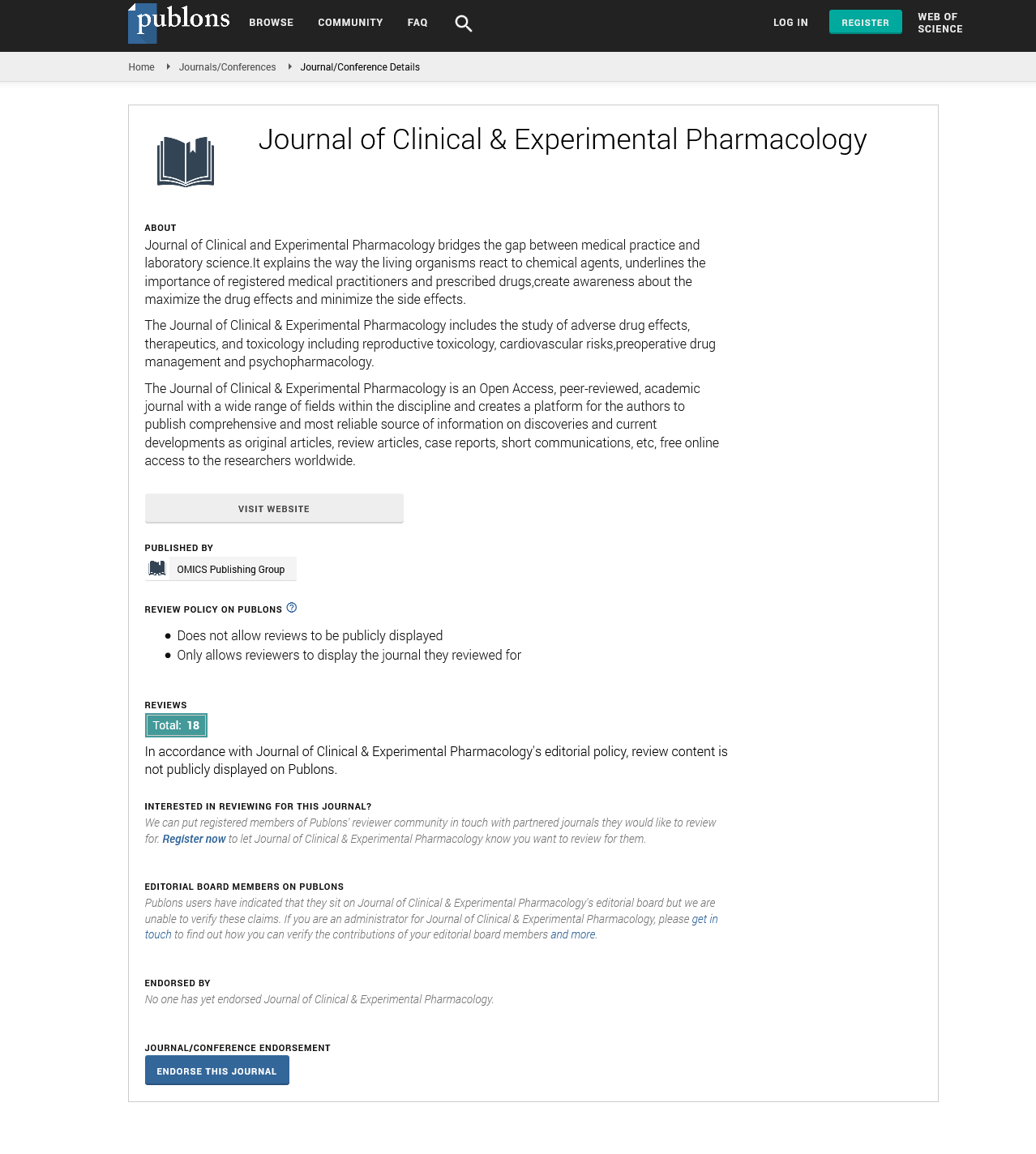Indexed In
- Open J Gate
- Genamics JournalSeek
- China National Knowledge Infrastructure (CNKI)
- Ulrich's Periodicals Directory
- RefSeek
- Hamdard University
- EBSCO A-Z
- OCLC- WorldCat
- Publons
- Google Scholar
Useful Links
Share This Page
Journal Flyer

Open Access Journals
- Agri and Aquaculture
- Biochemistry
- Bioinformatics & Systems Biology
- Business & Management
- Chemistry
- Clinical Sciences
- Engineering
- Food & Nutrition
- General Science
- Genetics & Molecular Biology
- Immunology & Microbiology
- Medical Sciences
- Neuroscience & Psychology
- Nursing & Health Care
- Pharmaceutical Sciences
Opinion Article - (2024) Volume 14, Issue 6
Evaluating the Efficacy of Nanoparticle-Based Drug Delivery Systems in Treating Neurodegenerative Diseases
Nikolaos Koumallos*Received: 23-Nov-2024, Manuscript No. CPECR-24-28072; Editor assigned: 25-Nov-2024, Pre QC No. CPECR-24-28072 (PQ); Reviewed: 09-Dec-2024, QC No. CPECR-24-28072; Revised: 16-Dec-2024, Manuscript No. CPECR-24-28072 (R); Published: 23-Dec-2024, DOI: 10.35248/2161-1459.24.14.453
Description
The search to develop effective treatments for neurodegenerative diseases such as Alzheimer’s, Parkinson’s and Huntington’s diseases has remained a significant challenge for modern medicine. These disorders, characterized by the progressive loss of neuronal structure and function, significantly impact millions of individuals worldwide. Conventional therapeutic approaches often struggle to achieve desired outcomes due to the complexity of the Blood-Brain Barrier (BBB), which serves as a protective mechanism but simultaneously restricts the delivery of many therapeutic agents to the brain. In this context, nanoparticle-based drug delivery systems have emerged as a potential alternative to overcome these limitations and enhance treatment efficacy.
Nanoparticles are engineered to deliver drugs at a targeted site, improving their bioavailability and minimizing off-target effects. Their small size, modifiable surface characteristics and ability to encapsulate diverse therapeutic molecules make them uniquely suited for crossing the BBB. This barrier, composed of endothelial cells joined by tight junctions, is highly selective and often excludes most macromolecules, including conventional drugs. Nanoparticle based carriers, however, can be designed to exploit specific transport mechanisms such as receptor-mediated transcytosis or adsorptive-mediated endocytosis, enabling therapeutic compounds to reach the central nervous system more effectively.
Several types of nanoparticles, including liposomes, polymeric nanoparticles, dendrimers and inorganic nanoparticles, have been described for drug delivery to the brain. Liposomes, composed of lipid bilayers, are particularly attractive due to their biocompatibility and capacity to encapsulate both hydrophilic and hydrophobic drugs. Polymeric nanoparticles, made from biodegradable polymers such as Polylactic-co-Glycolic Acid (PLGA), suggest controlled drug release and stability. Meanwhile, inorganic nanoparticles, such as gold and silica nanoparticles, provide unique optical and magnetic properties that can be controlled for imaging and therapy.
The therapeutic potential of nanoparticle-based systems in neurodegenerative diseases has been demonstrated in various preclinical studies. For instance, in Alzheimer’s disease, nanoparticles have been used to deliver anti-amyloid-β antibodies or small molecules that inhibit amyloid-β aggregation. These interventions aim to mitigate the formation of amyloid plaques, one of the pathological signs of Alzheimer’s. Similarly, in Parkinson’s disease, nanoparticle-mediated delivery of dopamine or neuroprotective agents has shown potential in restoring dopaminergic function and preventing neuronal loss. Such targeted approaches not only improve drug delivery to the brain but also reduce systemic side effects, which are often a limitation of conventional therapies.
Despite the potential of nanoparticle-based drug delivery systems, their clinical translation faces several hurdles. One significant concern is the potential for toxicity. The long-term effects of nanoparticles, particularly inorganic ones, on the human body and the environment remain largely unknown. Ensuring biocompatibility and biodegradability while maintaining efficacy is important. Additionally, the scalability of nanoparticle production and the associated costs pose challenges for widespread application. Regulatory hurdles also complicate the clinical approval process, as nanoparticle-based drugs require rigorous evaluation to ensure their safety and efficacy.
Another critical factor in evaluating the efficacy of nanoparticle based systems is their ability to achieve sustained therapeutic effects. While many preclinical studies report positive outcomes, the duration of these effects and their applicability to the heterogeneity of neurodegenerative diseases require further investigation. Neurodegenerative disorders are multifaceted, involving complex genetic, environmental and cellular factors. Thus, a one-size-fits-all approach is unlikely to be effective. Personalized nanoparticle formulations customized to individual patient profiles may suggest a solution, but they also introduce additional layers of complexity to the development process.
Moreover, the integration of advanced technologies such as artificial intelligence and machine learning holds potential for optimizing nanoparticle design and predicting their behavior in biological systems. These tools can accelerate the identification of optimal nanoparticle compositions and improve the precision of targeting mechanisms. For instance, computational models can simulate nanoparticle interactions with the BBB and predict drug release profiles, reducing the reliance on extensive in vivo testing.
Nanoparticle-based drug delivery systems represent an innovative approach to addressing the challenges of treating neurodegenerative diseases. Their ability to cross the blood-brain barrier and deliver therapeutic agents with high specificity and efficiency sets them apart from conventional methods. However, realizing their full potential requires addressing concerns related to safety, scalability and regulatory compliance. Continued investment in research, coupled with advancements in technology and interdisciplinary collaboration, will be important in transforming these potential preclinical findings into viable clinical therapies. By overcoming these challenges, nanoparticle-based drug delivery systems could revolutionize the management of neurodegenerative diseases and suggest to patients and their families.
Citation: Koumallos N (2024). Evaluating the Efficacy of Nanoparticle-Based Drug Delivery Systems in Treating Neurodegenerative Diseases. J Clin Exp Pharmacol. 14:453.
Copyright: © 2024 Koumallos N. This is an open-access article distributed under the terms of the Creative Commons Attribution License, which permits unrestricted use, distribution, and reproduction in any medium, provided the original author and source are credited.

